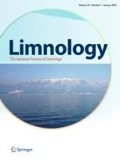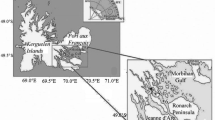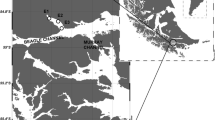Abstract
The lipid and fatty acid content of benthopelagic scavenging amphipods Ommatogammarus flavus and O. albinus from different depths of Lake Baikal were studied. These amphipods, known to move across a wide range of depths in Lake Baikal, had a relatively high level of total lipids (up to 46% dry weight) in comparison to other aquatic amphipods. This high level of total lipids resulted from a high concentration of storage lipids (triacylglycerols). The monounsaturated 18:1(n-9) acid in combination with 16:1(n-7), and 18:1(n-7) fatty acids were dominant in the amphipods, reflecting their deep-dwelling scavenging mode of life. Local groups of amphipods were distinguished along a Lake Baikal depth gradient based on the primarily diet-associated differences in fatty acid composition.





Similar content being viewed by others
References
Ackman RG, Hooper SN (1973) Non-methylene-interupted fatty acids in lipids of shallow-water marine invertebrates: a comparison of two molluscs (Littorina littorea and Lunatia triseriata) with the sand shrimp (Crangon septemspinosus). Comp Biochem Physiol B 46:153–165. https://doi.org/10.1016/0305-0491(73)90057-6
Allen EE, Bartlett DH (2002) Structure and regulation of the omega-3 polyunsaturated fatty acid synthase genes from the deep-sea bacterium Photobacterium profundum strain SS9The GenBank accession numbers for the sequences reported in this paper are AF409100 and AF467805. Microbiol 148(6):1903–1913. https://doi.org/10.1099/00221287-148-6-1903
Arts MT, Kohler CC (2009) Health and conditions in fish: the influence of lipids on membrane competency and immune response. In: Arts MT, Brett MT, Kainz MJ (eds) Lipids in aquatic ecosystems. Springer, Dordrecht, Heidelberg, London, New York, USA, pp 237–257
Atlas R, Busdosh M (1982) Bacterial populations associated with the Arctic amphipod Boeckosimus affinis. Can J Microbiol 28:92–99. https://doi.org/10.1139/m82-008
Axenov-Gribanov DV, Voytsekhovskaya IV, Tokovenko BT, Protasov ES, Gamaiunov SV, Rebets YV, Luzhetskyy AN, Timofeyev MA (2016) Actinobacteria isolated from an underground lake and moonmilkspeleo them from the biggest conglomeratic karstic cave in siberia as sources of novel biologically active compounds. PLoS ONE 11:e0149216. https://doi.org/10.1371/journal.pone.0149216
Bazarsadueva SV (2013) Ecological features of the distribution of lipids of hydrobionts in the deep-water zone of Lake Baikal. Dissertation, Irkutsk, Russia
Bazarsadueva SV, Radnaeva LD (2013) Fatty-acid composition of deep-water Baikal amphipods Ommatogammarus albinus. Chemistry for Sustainable Development 21:499–502. https://www.sibran.ru/upload/iblock/6a3/6a3e39912d2b8dc34d410d613f664440.pdf
Bazarsadueva SV, Radnaeva LD, Tulokhonov AK (2019) Comparative analysis of the fatty acid composition of deep-water Baikal amphipods. Crustaceana 92:57–72. https://doi.org/10.1163/15685403-00003856
Bazikalova AYa (1945) Amphipods of Lake Baikal. Tr. Baykal. Limnolog. st. 11:1–440
Bell JG, Sargent JR (2003) Arachidonic acid in aquaculture feeds: current status and future opportunities. Aquaculture 218:491–499. https://doi.org/10.1016/S0044-8486(02)00370-8
Belyaev G (1989) Deep-sea oceanic trenches and their fauna. Nauka, Moscow
Berkin NS, Makarov AA, Rusinek OT (2009) Baikal studies: studies allowance. Izd-vo Irkut. un-ta, Irkutsk, Russia
Boldyrev AA (1985) Biological membranes and ion transport. Moscow State University, Moscow
Boldyrev AA, Kaivarainen EI, Ilyukha VA (2006) Biomembranology: study guide. KarRC RAS, Petrozavodsk, Russia
Britton JC, Morton B (1994) Marine carrion and scavengers. Oceanogr Mar Biol Ann Rev 32:369–434
Bühring SI, Christiansen B (2001) Lipids in selected abyssal benthopelagic animals: links to the epipelagic zone? Prog Oceanogr 50:369–382. https://doi.org/10.1016/S0079-6611(01)00061-1
Clarke G, Stilling RM, Kennedy PJ, Stanton C, Cryan JF, Dinan TG (2014) Minireview: Gut microbiota: the neglected endocrine organ. Mol Endocrinol 28:1221–1238
Dalsgaard J, St John M, Kattner G, Muller-Navarra D, Hagen W (2003) Fatty acid trophic markers in the pelagic marine environment. Adv Mar Biol 46:225–340. https://doi.org/10.1016/S0065-2881(03)46005-7
DeLong EF, Yayanos AA (1986) Biochemical function and ecological significance of novel bacterial lipids in deep-sea procaryotes. Appl Environ Microbiol 51(4):730–737
Drazen JC, Phleger CF, Guest MA, Nichols PD (2008) Lipid, sterols and fatty acids of abyssal polychaetas, crustaceans, and a cnidarian from the northeast Pacific Ocean. MEPS 372:157–167. https://doi.org/10.3354/meps07707
Dybowsky BN (1874) Beiträge zur näheren Kenntris der in dem Baikal-See vorkommenden niederen Krebse aus der Gruppe der Gammariden. In: Herausgegeben von der Russ. Entomol. Gesellsch. Zu St. Petersburg. Buchdr. Von W. Besobrasoff and Comp., St. Petersburg, Russia
Engelbrecht FM, Mari F, Anderson JT (1974) Cholesterol determination in serum. A rapid direction method. S Afr Med J 48(7):250–256
Falk-Petersen S, Hagen W, Kattner G, Clarke A, Sargent J (2000) Lipids, trophic relationships, and biodiversity in Arctic and Antarctic krill. Can J Fish Aquat Sci 57:178–191. https://doi.org/10.1139/f00-194
Folch J, Lees M, Sloan-Stanley GH (1957) A simple method for the isolation and purification of total lipids animal tissue (for brain, liver and muscle). J Biol Chem 226:497–509
Gergs R, Steinberger N, Basen T, Martin-Creuzburg D (2014) Dietary supply with essential lipids affects growth and survival of the amphipod Gammarus roeselii. Limnologica 46:109–115. https://doi.org/10.1016/j.limno.2014.01.003
Gladyshev MI, Arts MT, Sushchik NI (2009) Preliminary estimates of the export of omega-3 highly unsaturated fatty acids (EPA+ DHA) from aquatic to terrestrial ecosystems. Lipids in aquatic ecosystems. Springer, New York, NY, pp 179–210
Gladyshev MI, Kolmakova OV, Tolomeev AP, Anishchenko OV, Makhutova ON, Kolmakova AA, Sushchik NN (2015) Differences in organic matter and bacterioplankton between sections of the largest Arctic river: Mosaic or continuum? Limnol Oceanogr 60(4):1314–1331. https://doi.org/10.1002/lno.10097
Graeve M, Hagen W, Kattner G (1994) Herbivorous or omnivorous? On the significance of lipid composition as trophic markers in Antarctic copepods. Deep-Sea Res I 41:915–924
Graeve M, Dauby P, Scailteur Y (2001) Combined lipid, fatty acid and digestive tract content analyses: a penetrating approach to estimate feeding model of Antarctic amphipods. Polar Biol 24:853–862. https://doi.org/10.1007/s003000100295
Hill C, Quigley MA, Cavaletto JF, Gordon W (1992) Seasonal changes in lipid content and composition in the benthic amphipods Monoporeia affinis and Pontoporeia femorata. Limnol Oceanogr 37:1280–1289. https://doi.org/10.4319/lo.1992.37.6.1280
Hochachka PW, Somero GN (2002) Biochemical adaptation: mechanism and process in physiological evolution. Oxford University Press, NY
Howell KL, Pond DW, Billett DSM, Tyler PA (2003) Feeding ecology of deep-sea seastars (Echinodermata: Asteroidea): a fatty-acid biomarker approach. Mar Ecol Prog Ser 255:193–206
Ivanter EV, Korosov AV (2010) Elementary biometry. Petrozavodsk, Russia
Jamieson GR (1975) GLC-identification techniques for long chain unsaturated fatty acids. J Chromatogr Sci 13(10):491–497. https://doi.org/10.1093/chromsci/13.10.491
Kabakov RI (2016) R in action. Analysis and visualization of data in the program R. DMK Press, Moscow, Russia, 588 p
Kato M, Hayashi R (1999) Effects of high pressure on lipids and biomembranes for understanding high-pressure-induced biological phenomena. Biosci Biotechnol Biochem 63:1321–1328. https://doi.org/10.1271/bbb.63.1321
Khelashvili G, Johner N, Zhao G, Harries D, Scott HL (2014) Molecular origins of bending rigidity in lipids with isolated and conjugated double bonds: the effect of cholesterol. Chem Phys Lipids 178:18–26. https://doi.org/10.1016/j.chemphyslip.2013.12.012
Kolotilo LG (2001) Problems of the physical-geographical study of Lake Baikal. Russian. geo about-in, SPb, Russia
Kozhova OM, Izmest’eva LR (1998) Lake Baikal evolution and biodiversity. Buckhuys Publishers, Leiden
Kraft A, Graeve M, Janssen D, Greenacre M, Falk-Petersen S (2015) Arctic pelagic amphipods: lipid dynamics and life strategy. J Plankton Res 37:790–807. https://doi.org/10.1093/plankt/fbv052
Lapin VI, Shatunovsky MI (1981) Features of composition, physiological and ecological value of fish lipids. Uspehi sovremennoi biologii 92(6):380–394
Legeżyńska J, Kedra M, Walkusz W (2012) When season does not matter: summer and winter trophic ecology of Arctic amphipods. Hydrobiol 684:189–214. https://doi.org/10.1007/s10750-011-0982-z#citeas
Lehninger AL, Nelson DL, Cox MM (1993) Principles of biochemistry. Worth Publishers, New York
Lewis RW (2011) Fatty acid composition of some marine animals from various depths. J Fish Res Board Can 24(5):1101–111510
Makhutova ON, Shulepina SP, Sharapova TA, Kolmakova AA, Glushchenko LA, Kravchuk ES, Gladyshev MI (2018) Intraspecies variability of fatty acid content and composition of a cosmopolitan benthic invertebrate Gammarus lacustris. Inland Waters 8(3):356–367. https://doi.org/10.1080/20442041.2018.1487157
Morris RJ (1984) The endemic faunae of Lake Baikal: their general biochemistry and detailed lipid composition. Proc R Soc London B Biol Sci 222(1226):51–78
Murzina SA (2010) The role of lipids and their fatty acid components in the biochemical adaptations of the daubed shanny Leptoclinus maculatus F. of the northwestern coast of Svalbard. Dissertation (Ph.D.), Petrozavodsk, Russia
Murzina SA (2019) The role of lipids and fatty acids in ecology and biochemical adaptations of fish from North seas. Dissertation (Dr.Sci.), Moscow, Russia
Nelson MM, Mooney BD, Nichols PD, Phleger CF (2001) Lipids of Antarctic Ocean amphipods: food chain interactions and the occurrence of novel biomarkers. Marine Chem 73:53–64. https://doi.org/10.1016/S0304-4203(00)00072-4
Nemova NN, Nefedova ZA, Murzina SA, Veselov AE, Ripatti PO, Pavlov DS (2015) The effect of environmental conditions on the dynamics of fatty acids in juveniles of the Atlantic salmon (Salmosalar L.). Russ J Ecol 46(3):267–271. https://doi.org/10.1134/S106741361503008X
Nichols DS, Nichols PD, McMeekin TA (1993) Polyunsaturated fatty acids in Antarctic bacteria. Antarctic Sci 2:149–160
Ntambi JM (1999) Regulation of stearoyl-CoA desaturase by polyunsaturated fatty acids and cholesterol. J Lipid Res. 40:1549–1558
Nygård H, Berge J, Søreide JE, Vihtakari M, Falk-Petersen S (2012) The amphipod scavenging guild in two Arctic fjords: seasonal variations, abundance and trophic interactions. Aquat Biol 14:247–264. https://doi.org/10.3354/ab00394
Parzanini C, Parrish CC, Hamel J-F, Mercier A (2018) Functional diversity and nutritional content in a deep-sea faunal assemblage through total lipid, lipid class, and fatty acid analyses. PLoS ONE 13(11):e0207395. https://doi.org/10.1371/journal.pone.0207395
Pond DW, Allen CE, Bell MV, Van Dover CL, Fallick AE, Dixon DR, Sargent JR (2002) Origins of long-chain polyunsaturated fatty acids in the hydrothermal vent worms Ridgeia piscesae and Protis hydrothermica. Mar Ecol Prog Ser 225:219–226
Protasov ES, Axenov-Gribanov DV, Voytsekhovskaya IV, Timofeyev MA (2016) Assessment of actinobacteria role in activity of deep-water endemic amphipod species belonging to the genus Ommatogammarus. J Stress Physiol Biochem 12(4):23–30
Radnaeva LD, Popov DV, Grahl-Nielsen O, Khanaev IV, Bazarsadueva SV, Käkelä R (2017) Fatty acid composition in the white muscle of Cottoidei fishes of Lake Baikal reflects their habitat depth. Environ Biol Fish 100:1623–1641. https://doi.org/10.1007/s10641-017-0670-6
Sargent J, Parkes RJ, Mueller-Harvey I, Henderson RJ (1987) Lipid biomarkers in marine ecology. In: Sleigh MA (ed) Microbes in the sea. Ellis Harwood, Chichester, pp 119–138 https://ci.nii.ac.jp/naid/10008557822/
Shatunovsky MI (1980) Ecological patterns of marine fish metabolism. Nauka, Moscow
Shi L, Xiao W, Liu Z, Pan B, Xu Y (2018) Diet change of hadal amphipods revealed by fatty acid profile: a close relationship with surface ocean. Mar Environ Res 142:250–256. https://doi.org/10.1016/j.marenvres.2018.10.012
Shulman GYe, Yuneva TV (1989) Ecological and physiological aspects of the study of fish lipids. Ekologicheskaya fiziologiya i biohimiya ryb: abstracts. Yaroslavl', Russia, pp 244–246
Sideleva VG (1996) Comparative character of the deep-water and inshore cottoid fishes endemic to Lake Baikal. J Fish Biol 49:192–206
Sidorov VS, Lizenko EI, Bolgova OM, Nefedova ZA (1972) Fish Lipids. 1. Methods of analysis. Tissue specificity of whitefish Coregonus albula L. In: Lososevyye (Salmonidae) Karelii. Karel. Fil. AN SSSR, Petrozavodsk, Russia, pp 152–163
Takhteev VV (2000) Essays on the specimens of Lake Baikal (systematics, comparative ecology, evolution). Izd-vo Irkut. un-ta, Irkutsk
Takhteev VV (2009) Deep-water amphipods of Lake Baikal, collected from Paisis submarine habitable vehicles. Baikal Zoo J 2:13–16
Takhteev VV (2016) Endemic amphipods (Crustacea: Amphipoda) of Lake Baikal as ecological analogues of life forms of the highest crustaceans of the World Ocean. Marine biological research: achievements and prospects: in 3 volumes: collection of materials. Vseros. scientific and practical conf. from int. participation dedicated to the 145th anniversary of the Sevastopol Biological Station (Sevastopol, September 19–24, 2016). ECOSI-Hydrophysics, Sevastopol 2:166–169 (In Russ)
Takhteev VV, Berezina NA, Sidorov DA (2015) Checklist of the Amphipoda (Crustacea) from continental waters of Russia, with data on alien species. Arthropoda Selecta. 24(3):335–370
Timofeyev MA, Shatilina ZM, Kolesnichenko AV, Kolesnichenko VV, Pflugmacher S, Steinberg CEW (2006) Natural organic matter (NOM) promotes oxidative stress response in freshwater amphipods Gammaruslacustris Sars and G. tigrinus (Sexton). Sci Total Environ 366(2–3):673–681. https://doi.org/10.1016/j.scitotenv.2006.02.003
Tkach NP, Vysotskaya RU (2007) Comparative study of the lipid composition of amphipods dwelling in conditions of different salinity. Fundamental'nyye issledovaniya. 10:89–90. http://fundamental-research.ru/ru/article/view?id=4520
Tocher DR (2003) Metabolism and functions of lipids and fatty acids in teleost fish. Rev Fish Sci 11:107–184. https://doi.org/10.1080/713610925
Tsyganov EP (1971) Method of direct methylation of lipids after TLC without elution with silica gel. Labor. Delo. 8:490–493
Velansky PV, Kostetsky EYa (2008) Lipids of marine cold-water fish. Russ J Mar Biol 34(1):51–56. https://doi.org/10.1134/S1063074008010070
Zhang W, Watanabe HK, Ding W, Yi Lan Y, Tian R-M, Sun J, Chen C, Cai L, Li Y, Oguri K, Toyofuku T, Kitazato H, Drazen JC, Bartlett D, Qiana P-Y (2018) Gut microbial divergence between two populations of the hadal amphipod Hirondellea gigas. Appl Environ Microbiol 85:e02032-18
Acknowledgements
The authors would like to thank Z.A. Nefedova and E.V. Borvinskaya for their initiative and cooperation during the study.
Funding
The study was carried out with financial support for the budget-funded research area of KarRC RAS [# 0218-2019-0076] (lipid and fatty acid profile analysis including statistical analysis and discussion) and under state assignment [# FZZE-2020-0026], with partial financial support from the Russian Foundation for Basic Research and Government of the Irkutsk Region [grant # 17-44-388067 r-a] (sampling of amphipods), and the Russian Science Foundation [# 20-64-46003]. Financial and technical support was received also from the Baikal Research Centre, Lake Baikal Foundation, and M. Lomonosov International Joint Program between DAAD and the Ministry of Education and Science of the Russian Federation.
Author information
Authors and Affiliations
Corresponding author
Ethics declarations
Conflict of interest
The authors declare no competing interests.
Ethical approval
The authors declare to have no conflict of interest and that all applicable institutional, national, or international guidelines for the use and care of animals were strictly followed in the present study.
Additional information
Publisher's Note
Springer Nature remains neutral with regard to jurisdictional claims in published maps and institutional affiliations.
Handling Editor: Marianne V. Moore.
Rights and permissions
About this article
Cite this article
Pekkoeva, S.N., Voronin, V.P., Shatilina, Z.M. et al. Lipid and fatty acid composition of scavenging amphipods Ommatogammarus spp. from different depths of lake Baikal. Limnology 22, 299–311 (2021). https://doi.org/10.1007/s10201-021-00657-z
Received:
Accepted:
Published:
Issue Date:
DOI: https://doi.org/10.1007/s10201-021-00657-z




